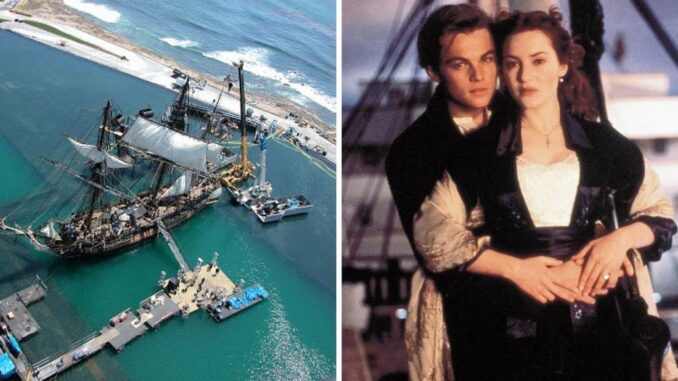
What Really Happened in This Mexican Town After Titanic Was Filmed There
The salt-licked air of Playas de Rosarito, Baja California, once carried the scent of grilled fish and the distant murmur of the Pacific. It was a sleepy, unpretentious Mexican coastal town, a weekend escape for Californians, where simplicity was a virtue and the rhythm of life was dictated by the tides. Then, in the mid-1990s, an iceberg of ambition hit, not in the icy North Atlantic, but squarely on its sun-drenched shores. James Cameron, a visionary with an insatiable appetite for the epic, decided that this unassuming stretch of sand would be the birthplace of his cinematic leviathan: Titanic.
What followed was less an economic boom and more a sudden, disorienting baptism by blockbuster. It began with an invasion. Not of soldiers, but of trucks, cranes, film crews, and a tidal wave of American dollars. The tranquil coastline was transformed into a colossal construction site. Locals watched, agape, as a gargantuan water tank rose from the earth, eventually holding 17 million gallons of seawater, large enough to contain the partial replica of the ill-fated liner. Temporary hotels sprung up, restaurants swelled with new patrons, and the once-quiet streets bustled with a new kind of energy – the frantic, ceaseless hum of Hollywood production.
For the people of Rosarito, it was a dizzying whirlwind. Jobs, once scarce, proliferated overnight. Fishermen traded their nets for hammers and worked as set builders. Waiters served Leonardo DiCaprio and Kate Winslet. Local cooks learned to cater to the finicky palates of a demanding film crew. The minimum wage, a grim reality for many, was suddenly eclipsed by unheard-of hourly rates. Dreams, previously confined to the realm of fantasy, seemed to bloom in the sudden, unexpected fertile ground of opportunity. Children stared at the flickering lights of the massive set at night, their imaginations soaring with tales of movie stars and immense wealth. Rosarito became a star itself, if only a backdrop, its name whispered in industry circles around the globe.
Yet, when the cameras ceased rolling and the last of the crew departed, taking with them the glittering promise and the cacophony of construction, a profound silence descended. The initial, intoxicating rush of prosperity evaporated, leaving behind a complex legacy. Many of the temporary jobs vanished, and the elevated wages became a distant memory. Some, having tasted a different kind of life, found it hard to return to the rhythms of the old Rosarito. There was a hangover, a slight disorientation, a question mark hanging over the town: What now?
What really happened was a permanent redefinition of Rosarito’s identity. The film didn't just leave behind memories; it left a massive, purpose-built studio facility. What was once the largest outdoor filming tank in the world, along with sound stages and production offices, became Foxploration (now Baja Studios). The idea was to transform Rosarito into a permanent international film hub, a "Hollywood South." While other major productions did follow—Master and Commander: The Far Side of the World, Tomorrow Never Dies (parts of it)—the consistent stream of blockbuster work never quite materialized to the extent initially hoped. The geographic proximity to Hollywood was a boon, but other factors, like changing global film economies and shifting perceptions of border regions, played their part.
The intangible impact, however, was perhaps more significant. Rosarito became "that place where Titanic was filmed." This association, for better or worse, became an indelible part of its brand. Tourism, already a pillar of the local economy, shifted. While still attracting partygoers and those seeking a quick beach getaway, there was also a new, curious contingent: film buffs hoping to catch a glimpse of the spectral hulks of the set or simply soak in the cinematic history. Restaurants, even years later, would display faded photos of cast members, capitalizing on the lingering allure.
For the town itself, the Titanic experience was a jarring, accelerated lesson in globalization. It showed them the immense power of external investment and the fleeting nature of temporary booms. It exposed them to a different culture, a different set of expectations. While some might argue it led to an erosion of the town's original, quieter charm, it also undeniably elevated its profile and diversified its economy in ways that might have taken decades otherwise. It planted the seed for a more ambitious, internationally-minded future, even if that future proved more challenging and nuanced than the initial dream.
Today, Playas de Rosarito is still Rosarito. The scent of grilled fish still mingles with the sea breeze. But beneath the surface, there's an undeniable layer of history – a colossal, cinematic footprint etched onto its soul. The studio stands, a monument to a moment when a small Mexican town became, for a brief, dazzling period, the center of the cinematic universe. What really happened was that Rosarito learned that sometimes, the greatest adventures aren't just on the silver screen, but in the very real, often unpredictable, transformation of a place by the sheer force of Hollywood's ambition. It didn't just host a film; it was fundamentally altered by the sinking, and subsequent resurrection, of a dream.
